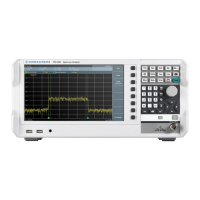The Spectrum Application
R&S
®
FPC
104User Manual 1178.4130.02 ─ 07
Defining a display range
The display range determines the scale or resolution of the y-axis.
In the default state, the display range is a logarithmic scale over a 100 dB. This scale
corresponds to a resolution of 10 dB per grid division. The R&S FPC provides other
display ranges that either increase or decrease the resolution of the y-axis.
Note that increasing the resolution of the y-axis does not increase the accuracy of
measurement results. It merely makes it easier to read the values of the trace.
You can also select a linear scale for the vertical axis. In that case, the power levels
are expressed as a percentage of the reference level. A linear scale is useful, for
example, to display AM modulated carriers in the time domain.
1. Press the "Ampt" key to open the amplitude menu.
2. Select the "Range / Ref Position" menu item to open the display range menu.
3. Select the display range you need.
● "Auto Range"
Automatically scales the y-axis for an ideal display of the measured signal.
● "Range <x> dB"
Opens an input field to define a custom display range.
● "Linear 0 - 100 %"
Changes the scale into a linear scale.
Note that "Auto Range" is not supported for a linear y-axis scale.
The R&S FPC adjusts the vertical axis accordingly.
14.4.4 Transducers
The results of measurements with transducers or antennas usually need to be correc-
ted by their frequency characteristics. These correction values are defined in trans-
ducer factors. When you use a transducer factor, these correction values can be
directly considered in the measurement results.
A transducer factor consists of several data points, with each data point being defined
by a frequency and the corresponding correction value for that frequency. The unit of
the correction value depends on the transducer you are using. Field-strength measure-
ments with an antenna, for example, indicate the electrical field strength in dBµV, so
the transducer factor has to define its level values in dBµ, too.
You can also use a transducer factor to correct a frequency-dependent attenuation,
e.g. of a cable between DUT and RF input of the R&S FPC.
You can create and edit transducer factor with the R&S InstrumentView software pack-
age and then transfer them into the internal memory of the R&S FPC. Each transducer
factor can consist of up to 1000 reference values.
Interpolation between the values is performed with the aid of a modified spline algo-
rithm. Even if only relatively few values such as maxima, minima and turning points are
available, this algorithm can easily simulate the correction factors of common transduc-
Amplitude Configuration

